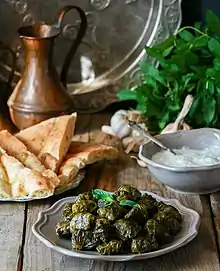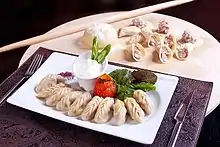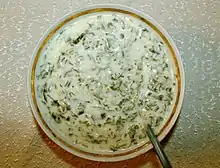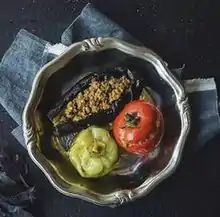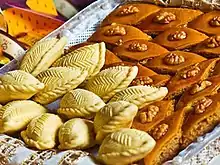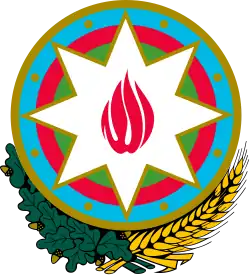Azerbaijani cuisine
Azerbaijani cuisine (Azerbaijani: Azərbaycan mətbəxi) refers to the cooking styles and dishes of the Republic of Azerbaijan.
| Part of a series on the |
| Culture of Azerbaijan |
|---|
 |
| History |
| People |
| Languages |
| Cuisine |
| Religion |
| Sport |
|
| Part of a series on |
| Azerbaijanis |
|---|
| Culture |
| Traditional areas of settlement |
| Diaspora |
| Religion |
| Language |
| Persecution |
|
History and features of Azerbaijan national cuisine
Azerbaijan's national cuisine is closer to Middle Eastern cuisine due to the taste and preparation of the dishes, as well as adding a dark spice and flavor additives. Contemporary Azerbaijan cuisine retains traditional methods of preparation of dishes while incorporating modern cooking requirements and preparations.
Azerbaijani dishes have traditionally been cooked with copper utensils in copper cookware. Copper bowls and plates are still commonly used as serving dishes.
Azerbaijani cuisine is full of different types of greens and vegetables such as aubergine, tomato, sweet pepper, spinach, cabbage, onion, sorrel, beet, radish, cucumber, green beans. Rice and products made from flour are widely used in national cuisine. It is famous for vegetables and greens used seasonally in the dishes. Fresh herbs, including mint, coriander, dill, basil, parsley, tarragon, leek, chive, thyme, marjoram, green onion, and watercress are very popular and often accompany main dishes. The majority of national dishes are prepared of lamb, beef and poultry meat. Dishes prepared of minced meat are more prevalent. The sea, lakes and rivers of the Republic of Azerbaijan are abundant with different fish species, particularly white sturgeon. Sturgeon fish is widely used in preparation of national dishes. The Caspian Sea is home to many edible species of fish, including the sturgeon, Caspian salmon, kutum, sardines, grey mullet, and others. Black caviar from the Caspian Sea is one of Azerbaijan's best known delicacies well sought after in other parts of the world, including former Soviet countries.
One of the most reputed dishes of Azerbaijani cuisine is plov from saffron-covered rice, served with various herbs and greens, a combination totally distinct from those found in Uzbek plovs. Azerbaijani cuisine includes more than 40 different plov recipes. Other second courses include a wide variety of kebabs and shashlik, including lamb, beef, chicken, duck and fish (baliq) kebabs. Sturgeon, a common fish, is normally skewered and grilled as a shashlik, being served with a tart pomegranate sauce called narsharab. Dried fruits and walnuts are used in many dishes. The traditional condiments are salt, black pepper, sumac, and especially saffron, which is grown domestically on the Absheron Peninsula. The third courses include soups, of which there are more than 30 types in Azerbaijani national cuisine. These include kufta bozbash, piti prepared of meat and dovga, ovdukh, dogramach, bolva prepared of greens and yoghurt. Some soups are served in national or interesting and unusually-shaped bowls.
Black tea is the national beverage, and is drunk after food is eaten. It is also offered to guests as a gesture of welcome, often accompanied by fruit preserves.[1]
Light snacks
Azerbaijani cuisine has a number of light snacks and side dishes to open or accompany the main meals: a plate of aromatic green leaves called goy, pieces of chorek (bread), choban (a tomato and cucumber salad), and sometimes white cheese or qatik (sour yogurt). Cold snacks are generally served separately from the drinks.
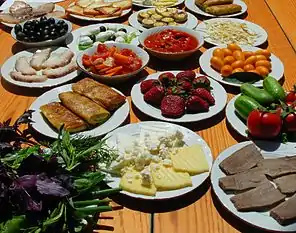 Light snacks of Azerbaijani cuisine
Light snacks of Azerbaijani cuisine
Dishes
Meat
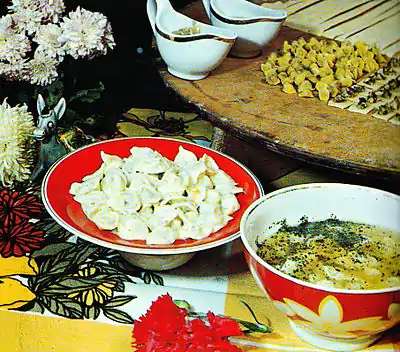
Historically, Azerbaijani cuisine had included large amounts of beef and game. Consumption of camel meat had also been widespread, although it has become increasingly rare in the modern times. In order to preserve meat it was historically jerked, or alternatively, roasted and stuffed into jars or animal stomachs. Apart from the conventional cuts of meat, Azerbaijani cuisine features the use of head, legs, tails and intestines of animals in numerous traditional dishes.[2]
Azerbaijani cuisine features a wide variety of traditional meat dishes such as bozbash (parchabozbash, kuftebozbash, qovurmabozbash), piti (Gence piti, Sheki piti) khash, bash-ayaq (kelle-pacha), kelepir, soyutma, bozport, buglama, bozartma, and a variety of different Kebabs. A variety of lamb dishes are also commonly eaten, traditionally during celebrations such as Nowruz. Numerous meatball dishes and forms of dolma are consumed on a day-to-day basis as well. On particularly special occasions, local goose, turkey, duck, quail and pheasant meats are also cooked and consumed.
Furthermore, Azerbaijani cuisine also features a variety of seafood, especially fish which is obtained from the Caspian Sea as well as rivers Kura and Aras. Fish is prepared and cooked in a variety of ways: stuffed, chopped, dried, grilled, fried, boiled, cooked in the oven, cooked on skewers, cooked in tandoors, cooked into plovs, and in other ways depending on the occasion and personal preferences.[2]
| Name | Description |
|---|---|
| Balıq | Fish, usually sturgeon, normally skewered and grilled as a kebab, is served with a tart sour-plum sauce. |
| Dolma | The traditional recipe calls for minced lamb or beef mixed with rice and flavoured with mint, fennel, and cinnamon, and wrapped in vine leaves (yarpaq dolması) or cabbage leaves (kələm dolması). There are also sour sweet cabbage dolma (turş şirin kələm dolması) and eggplant dolma (qarabadımcan dolması). |
| Badımcan Dolması | Tomato, sweet pepper, and aubergine stuffed with minced lamb or beef mixed with chickpeas. |
| Dushbara | Small dumplings stuffed with minced lamb and herbs, served in broth. |
| Lavangi | stuffed chicken or fish with onions, walnuts, raisins, albukhara, and alcha seasoning. A specialty of the Talysh region in southern Azerbaijan, but very difficult to find common in restaurants. |
| Lyulya kabab | A mixture of mutton, herbs, and spices squeezed around a skewer and barbecued, often served with lavash (thin sheets of unleavened bread). |
| Qutab | A sort of pancake turnover stuffed with minced lamb, cheese, or spinach. |
| Tika kabab | Chunks of lamb marinated in a mixture of onion, vinegar, and pomegranate juice, impaled on a large skewer and grilled on the barbecue. In Russian, it is called shashlyk (шашлык), from Turkic shishlyk (literally, "for skewer"). |
| Qovurma | Pieces of mutton or lamb on the bone (blade chops) stewed with onions, tomatoes, and saffron.[3] There is also sabzi qovurma, a lamb stew with herbs. |
| Sogan dolmasi | The term dolma covers a variety of stuffed vegetable dishes, widespread in the Middle East and the Mediterranean. Onion dolma are a tasty winter alternative to stuffed aubergines, tomatoes, and peppers.[4] |
| Tebriz kuftesi | Large Azerbaijani meatball dish named after the Azerbaijani town of Tabriz in northern Iran. Prepared with minced meat, onions, peas, rice, potatoes, eggs, tomatoes, turmeric, and various herbs such as parsley, coriander and dill. |
| Bastirma | The word "Bastir" comes from the Turkish: bastırma et ("pressed meat"), pastırma [pastɯɾˈma] in modern Turkish. It's cooked as a kebab, but before cooking it should be marinated in special sauce and herbs. |
Soups
Unlike soups in other cultures, soups in Azerbaijan tend to have a thicker consistency and a larger ratio of dry ingredients to broth.[2] A common feature of numerous Azerbaijani soups is that the soup serves the role of both the first and second dishes[2] – the soup is served in a large portion and the broth is drunk first as a starter, and then the large, hearty dry ingredients of the soup such as the potatoes, meat, chickpeas and large vegetable chunks are consumed as a second dish together with bread.
Another characteristic featured in several Azerbaijani soups is the use of finely cut mutton tails which are added soups. Tomato paste and tomato puree are rarely used in Azerbaijani soups and instead are substituted with fresh local tomatoes during the summer.[2] During winter, local tomatoes are not widely available and so frequently substituted with dried cherries. Spices such as saffron and turmeric powder are also traditionally used in Azerbaijani soups.
| Name | Description |
|---|---|
| Piti | The national soup of Azerbaijan made from pieces of mutton on the bone, cooked with vegetables in a broth; prepared and served in individual crocks. |
| Kufta bozbash | A pea soup with lamb meatballs and boiled potatoes. The meatballs in kufta bozbash are large, hearty, and made of minced lamb or beef and rice, sometimes with a dried plum inside. |
| Etli lobya shorbasi | A soup made with broth, beans, onions, and small chunks of meat (mutton/beef). Various local vegetables often added depending on the preference and availability. |
| Sulu khingal | Lamb soup with noodles. |
| Toyuq shorbasi | Chicken soup. A wide variety of chicken soups using local vegetables are prepared and eaten during the entire year, but more frequently during fall and winter. |
| Balıq shorbasi | Fish soup. In the Azerbaijani tradition, the soup is typically prepared with the addition of potatoes, tomatoes, onions, various herbs (celery, thyme, parsley), and with olive oil, lemon juice, lemon zest, salt, and pepper to taste. Whitefish from the Caspian Sea is used for the soup. |
| Kartof shorbasi | Potato soup. Typically eaten in Azerbaijan during fall and winter, the soup is traditionally made with beef broth, onions, butter, flour, and of course potatoes, which are cooked together and puréed to a creamy consistency. Egg yolk and milk are sometimes added for flavor. |
| Dovga | A yogurt-based soup (matsoni) with sorrel, spinach, rice, dried peas, and small meatballs made from ground mutton; served hot or cold depending on the season.[5] |
| Ovdukh | A cold soup based on a matsoni–water mixture poured over sliced cucumbers, chopped boiled meat, quarters of hard-boiled egg, and greens (dill, coriander, basil, tarragon, and sometimes mint).[6] |
| Dogramach | Same as ovdukh, but without the meat.[6] |
| Bolva | Made with sour milk. |
Types of plov
.JPG.webp)
Plov is one of the most widespread dishes in Azerbaijan and there are over 200 types of plovs in Azerbaijani cuisine. They are usually prepared with a wide variety of local vegetables, meats and spices. In Azerbaijani tradition, it is customary that the household prepares a plov for guests visiting the house.[7] They are typically served in a large metal or porcelain bowl covered with a lid to keep it warm. The type of rice used to make the plov varies from one recipe to another and depends on personal preferences. Since plov is heavy, fatty food, it is traditionally served together with sour drinks such as ayran, black tea with lemon, or verjuice. Plovs have different names depending on the main ingredients accompanying the rice:
| Name | Ingredients |
|---|---|
| Kourma plov | Mutton plov with onion |
| Chilov plov | Bean plov with fish |
| Sabzi qovurma plov | Mutton plov |
| Toyug plov | Chicken plov |
| Shuyudli plov | Dill plov with beaf |
| Shirin plov | Dried fruit plov |
| Syudli plov | Rice cooked in milk |
| Sheshryanch plov | Six-color plov, eggs cooked "sunny side up" on a bed of fried green and white onions.[5] |
Azerbaijani plov consists of three distinct components, served simultaneously but on separate platters: rice (warm, never hot), gara, fried meat, dried fruits, eggs, or fish prepared as an accompaniment to rice, and aromatic herbs. Rice is not mixed with the other components even when eating plov.[8]
Desserts
Typical Azerbaijani desserts are sticky, syrup-saturated pastries such as pakhlava and Shaki halva. The former, a layer of chopped nuts sandwiched between mats of thread-like fried dough, is a specialty of Shaki in northwest Azerbaijan. Other traditional pastries include shekerbura (crescent-shaped and filled with nuts), peshmak (tube-shaped candy made out of rice, flour, and sugar), and girmapadam (pastry filled with chopped nuts).
Sweets are generally bought from a pastry shop and eaten at home or on special occasions such as weddings and wakes. The usual conclusion to a restaurant meal is a plate of fresh fruit that is in season, such as plums, cherries, apricots, or grapes.
In March 2009, Azerbaijani bakers achieved an entry in the CIS book of records for baking the biggest and heaviest pakhlava in the CIS, weighing about 3 tons. More than 7 thousand eggs, 350 kg of nuts, 20 kg of almonds, 350 kg of sugar, and the same amount of flour was used in the preparation of the pastry.[10]
| Name | Description |
|---|---|
| Pakhlava | The name of this pastry is derived from its diamond shape, symbolizing fire, which is called pakhla by Azerbaijani carpet specialists. It is one of the festive sweets baked on the eve of the arrival of Spring- the Nowruz holiday to honour the sun. |
| Shekerbura | Shekerbura (şəkərbura) is a popular Azerbaijani sweet pastry, filled with ground almonds, hazelnuts, or walnuts. The ancient name for this crescent-shaped pastry is Sheker Burek, a Turkic word meaning ‘sweet patty’. In Azerbaijan, it usually involves the teamwork of relatives, friends, and neighbors who congregate at someone's home to make this. Nowruz delights. What really makes these look rather spectacular is the pattern on the dough produced by the traditional tweezers called maggash. |
| Samani halva | Samani halva is made from malted wheat, and can be best described as a spicy, gooey, chewy treat. One samani halva tradition in Azerbaijan is to make halva communally, using flour from seven different homes.[11] |
| Shorgoghal | Another Novruz delicacy, Shorgoghal is a flaky pastry filled with turmeric, anise, caraway, cinnamon and black pepper. In ancient times, the yellow pastry represented the sun, while the crescent-shaped Shekerbura represented the moon. These rolls are time-consuming to prepare, but the process is not really complicated. |
| Guymag | This is a simple, rich dessert, traditionally offered to women who have just given birth or to patients after surgery to keep their strength up. It is high in calories and easy to prepare. It is also served as a hot breakfast when the weather is cold. |
| Firni | Firni is a dessert made from rice flour, which has a light texture and bland flavor, making it much lighter than British and North American baked rice puddings.[12] |
| Badambura | Badambura is slightly less sweet than pakhlava and has no honey so it is less sticky as well. It is filled with plain ground sugar, almonds (badam in Azerbaijani language), cardamom, and vanilla.[13] |
Dairy products
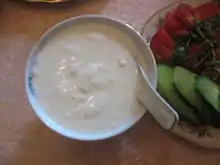
Milk and dairy products play an important role in Azerbaijani diet. Milk, butter, cream, sour cream, yogurt, cottage cheese, motal cheese, buttermilk, dovga, ayran, qatiq, suzme, and other dairy products are regularly consumed in the morning, as a snack, and even incorporated into lunch and dinner. Cow's milk is most often used to produce local dairy products, however sheeps' milk is also sometimes used and goats' milk is consumed for its perceived health benefits. Rural communities in Azerbaijan produce local butter, buttermilk and cheeses using traditional churning techniques.
| Name | Description |
|---|---|
| Ayran | A savory dairy drink. It is a staple of an Azerbaijani dinner/lunch table and is served cold. |
| Qatiq | A fermented, savory milk product. It is typically eaten with Qutabs or with bread. |
| Qurut | It is made from grain mixed with sour milk or yogurt. |
| Dovga | A vegetarian, yoghurt-based soup cooked with a variety of herbs. Coriander, dill, mint and rice are mainstays of the soup. |
| Shor | Azerbaijani cottage cheese. |
| Suzme | Creamy, fatty dairy product made from filtered and thickened qatiq. |
| Xinaliq pendiri | Khinalug cheese, produced in the ancient village of Khinalug. It is one of the most popular cheeses in Azerbaijan. |
| Motal pendiri | Motal cheese. Another type of cheese widely consumed in Azerbaijan. |
Breads

Different types of bread are baked in Azerbaijan like: flat, rolling, flatbread, lavash, sengek, xamrali, thick, thin, crepes, cakes, bread oven (tandoor bread).Tandoor bread is a type of bread baked in a clay oven called a tandoor. Mostly it is used for baking bread and cooking meat, but generally, any type of food can be cooked in tandoor ovens. The secret of the tandoor oven is the process of heating up the oven. Wood is put on the ground and ignited. It is necessary to wait until it becomes glowing charcoal. By this moment the oven will reach temperatures of around 400*C. The food is basically cooked from the heat of the walls. High temperature ensures very fast cooking. In the Middle Ages, tandoor oven was one of the common facilities of the population who lived in Old City (Icheri Sheher). This has been discovered during the archaeological excavations in different areas of Old City. During the meeting held in Ethiopia, the UNESCO Intergovernmental Committee for the Safeguarding of the Intangible Cultural Heritage decided to include lavash in the Representative List of the Intangible Cultural Heritage of the organization.[14][15]
Beverages
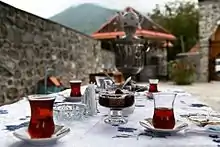
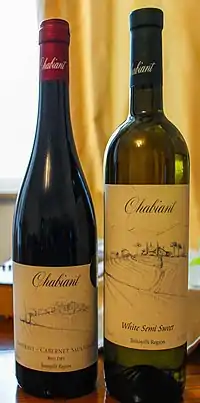
Black tea is Azerbaijan's national drink. Azerbaijani people usually prefer tea made in special equipment called samovar.
Ayran is a cold yogurt beverage mixed with salt.
An Azerbaijani sherbet (Azerbaijani: şərbət) is a sweet cold drink made of fruit juice mixed or boiled with sugar, often perfumed with rose water. Sherbets (not to be confused with sorbet ices) are of Iranian origin and they may differ greatly in consistency, from very thick and jam-like (as in Tajik cuisine) to very light and liquid, as in Azerbaijan.[16] Sherbets are typically prepared in the following natural flavors:
Locally made brands of bottled water include the following:[18]
| Brand | Origin | Originating area |
|---|---|---|
| Aysu | ||
| Badamlı | Badamli, Nakhchivan | |
| Sirab | Sirab, Nakhchivan | |
| Şollar | Şollar village | North-east |
| Tamiz gazh su | ||
| Qax | Qakh district | North[19] |
| Kakh | ||
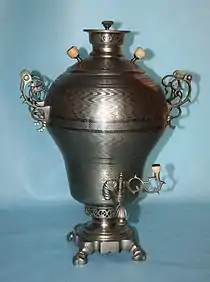 A samovar
A samovar
See also
References
- Based on the book Azerbaijani Cooking Archived 2009-02-16 at the Wayback Machine, Ishyg Publ. House, Baku (in Russian)
- "Azərbaycan mətbəxi". Azərbaycan Respublikası Mədəniyyət Nazirliyi. Retrieved 2021-01-31.
- "Lamb Cuisine Page – Catskill Merino Sheep Farm". www.catskill-merino.com. Archived from the original on 1 June 2017. Retrieved 22 May 2017.
- "News.Az – Sogan dolmasi – Onion dolma". www.news.az. Retrieved 22 May 2017.
- Azerbaijan cookery by category of dishes, a section of Large Guide to Home Cooking (in Russian)
- Dogramach and ovdukh Archived October 14, 2008, at the Wayback Machine: recipes for Azerbaijani soups (in Russian).
- "MİLLİ KULİNARİYANIN ÖZƏLLİKLƏRİ". Region Plus. Retrieved 2021-02-05.
- Interview with Jabar Mamedov Archived 2008-12-21 at the Wayback Machine, Head Chef at the "Shirvan Shah" Azerbaijani restaurant in Kiev, 31 January 2005.
- Once in a Lifetime Journey. "The Food Azerbaijan Food".
- "Huge pakhlava hits record in Ganja" Archived March 19, 2009, at the Wayback Machine on anspress.com. Retrieved on 17 March 2009
- "News.Az – Samani halva – Malted wheat halva". www.news.az. Retrieved 22 May 2017.
- "News.Az – Shekerbura – Sweet nut pies". www.news.az. Retrieved 22 May 2017.
- "The Best Azerbaijan Food". Once in a Lifetime Journey.
- "HugeDomains.com – KabobCentral.com is for sale (Kabob Central)". kabobcentral.com. Retrieved 22 May 2017. Cite uses generic title (help)
- "Archived copy". Archived from the original on 2008-12-21. Retrieved 2011-01-06.CS1 maint: archived copy as title (link)
- "Рецепты таджикской кухни – Шербеты". www.zdb.ru. Retrieved 22 May 2017.
- Recipes for lemon and mint sherbets (in Russian)
- Mineral Waters of the World: Azerbaijan
- Qakh or Kakh mineral water Archived April 2, 2007, at the Wayback Machine
External links
| Wikibooks Cookbook has a recipe/module on |
- AZ Cookbook: Food from Azerbaijan and Beyond
- Proverbs about Food in Azerbaijan, Azerbaijan International, Autumn 2000, pp. 36–37.
- Food! Glorious Food!, Special issue of Azerbaijan International, Autumn 2000.
- Azerbaijani dishes: photographs and descriptions
- Azerbaijani cuisine: descriptions of dishes by category on advantour.com
- Cuisine of Azerbaijan based on the book Azerbaijani Cooking published in Baku (in Russian)
- Selected recipes from Azerbaijani cuisine
